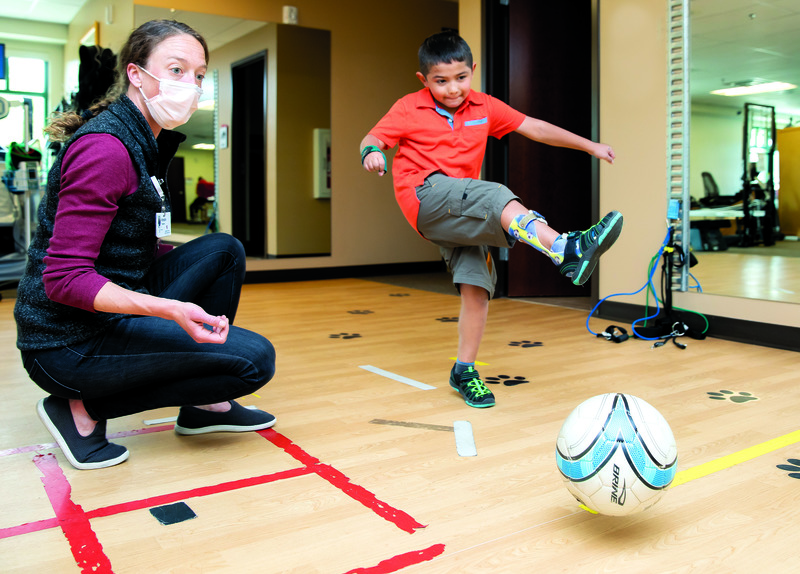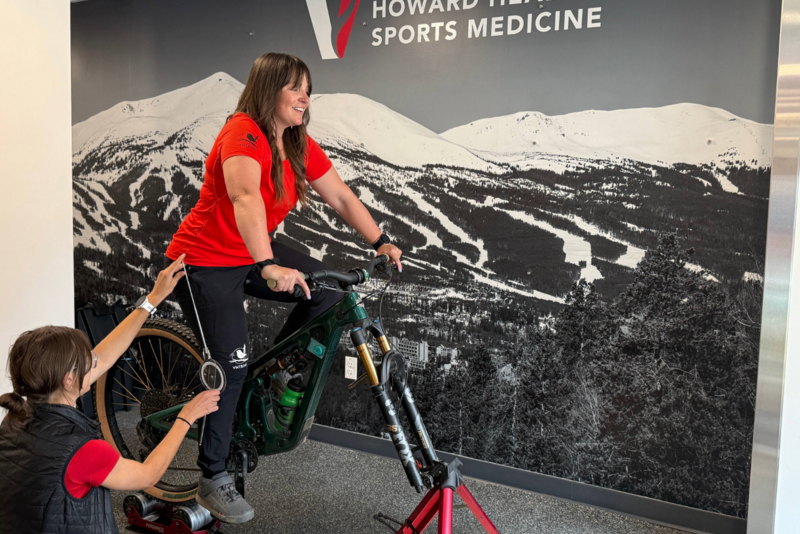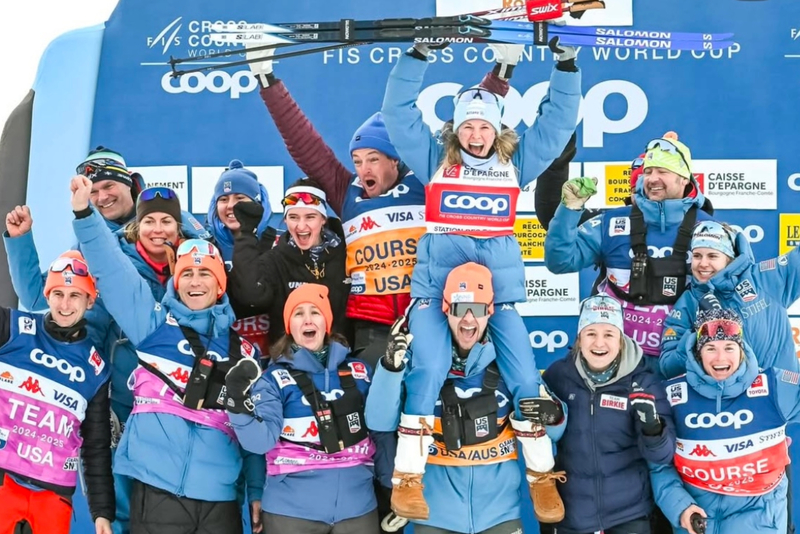News
Working Together: Howard Head Sports Medicine partnerships enhance recovery and quality of life
Kimberly Nicoletti | Photos by Dominique Taylor
March 23, 2022

EMERGENCY CARE
It’s uncommon to see physical therapists working alongside Emergency Department (ED) physicians, but at Vail Health, where many patients come in with orthopaedic injuries like sprains and breaks, they’re essential members of the care team.
In most EDs, patients are sent home with the simple guidance of an acronym: RICE, which stands for rest, ice, compress and elevate. Vail Health takes recovery one step further: patients are given an at-home exercise program they can start immediately to promote faster healing and less muscle atrophy.
“Immediate exercise decreases swelling, which is the biggest culprit of pain,” says Howard Head physical therapist Kristyn Petracek.
After an injury, muscles start to shut down in order to protect the body. Safe exercises activate the muscles without risking further damage, she says.
Immediate, proper exercises also allow patients to schedule surgery faster, if needed. Studies show that typically, due to swelling, surgery must be delayed about 20 days after an injury. By performing safe exercises right away, patients are able to reduce swelling and undergo surgery sooner, thereby getting them on a more direct path to recovery.
And, learning and practicing these safe movements with physical therapists in the ED helps ease patients’ minds.
“One of the things I’ve noticed in the Emergency Department is that people are very fearful that the exercises will hurt,” Petracek says. “When we do the exercises with them, it reduces their fear and avoidance, and promotes the physical activity that is so crucial for healing.”
Therapists in the ED are specially trained to evaluate and treat injuries, which adds to the quality of care without taking up patients’ valuable time. They tape and brace injuries as needed and even have a few stairsteps devoted to teaching people how to climb using crutches. Physical therapists from Howard Head’s Brain and Balance team assist with post-concussion recovery, educating patients on how to care for the head injury and prevent any further injuries.
“They make things go smoothly in the ED,” says Emergency Physician Dr. Eman Podgorny.
BRAIN AND BALANCE
Not so long ago, doctors sent con-cussed patients home to rest, thinking there wasn’t much else to help the brain recover. But studies show that balance exercises can help treat head injuries and other balance disorders.
For example, a 2014 study by Dr. Walter Schneider followed patients with sports-related concussions for eight weeks. Half underwent vestibular and upper cervical treatment, while the other half had no treatment. Of those who were treated for their concussions, 73% returned to their athletic lifestyles in eight weeks, whereas only 7% from the non-treatment group returned to sports by eight weeks. That's because manual treatments of the cervical spine help relieve pain from whiplash, balance exercises improve the vestibular system and vision and cognitive exercises aid in regaining concentration.
“The biggest thing we hear from patients is they didn’t know these issues could be worked on,” says Devyn Moore, a member of the Brain and Balance team.
“We have better diagnostic tools, like video goggles that show where dizziness originates, and we formulate treatment based on that. We can help people return to their sports by testing and passing them with criterion so they are safely able to return to activities and are not at a higher risk of another concussion.”
Desensitization and habituation also help people return to normal life activities. Controlled, progressive exposure to external environmental triggers and head motion movements help people get back to doing what they love sooner than the outdated advice of resting in a quiet, dark room, which has actually been found to be harmful, Moore says.
In addition to concussions, the Brain and Balance team treats dizziness and fall-related impairments so people can safely return to their active lifestyles. They focus on treating three elements that contribute to balance: vision, proprioception (knowing where the body is in space) and the vestibular system, located in the inner ear.
Most people with balance challenges rely heavily on their vision, while the other two systems—proprioception
and vestibular—begin to weaken, Moore says.
“We work on different strategies to compensate for the lack of vestibular system and proprioception,” Moore says.
Therapists train proprioception by practicing ankle, hip or step strategies on varying surfaces, from foam and slants to wobble boards. They strengthen the vestibular system by guiding patients through actions like walking while turning their head back and forth and, eventually, closing their eyes.
Preventing falls is especially important in older adults, because the risk of hip fracture leading to death increases in older populations, Moore says. At-risk patients practice losing their balance in a safe range, with a gait belt, by stepping and catching themselves, rather than actually falling.
PEDIATRICS
Whether it’s sports-related injuries, developmental delays, cerebral palsy, congenital defects or other conditions, the pediatric therapy team at Howard Head is committed to helping kids reach their full potential.
“Physical therapy is key to improving developmental delays so kids can get as close to normal function as possible—and they often can get all caught up to their peers in a short amount of time,” says Colorado Mountain Medical Pediatrician Dr. Janet Engle, who partners with Howard Head’s physical therapists to treat her patients.
Physical therapy reduces weaknesses ranging from walking to running, skipping and jumping. Gait impairments, such as walking with toes inward or outward, are also commonly treated.
Exercise programs are based on evaluations, as well as kids’ and parents’ goals. Specially-trained physical therapists like Kristin Thomas turn skill-based exercises into games (like picking up bean bags while squatting, jumping by "supercharging the rocket" or crawling like a bear) so kids have fun and stay motivated.
“Kids learn how to move their bodies and navigate their environments with balance and control,” Thomas says. “Being able to keep up with friends and gym class sets them up for a lifetime of success and general activity and wellbeing.”
Sometimes, parents think kids will just grow out of challenges they face, but early intervention can make a big difference. Changing movement patterns before they become ingrained and progress into worse problems is key.
“Catching it early before it becomes an issue helps set kids up for a lifetime of good habits,” Thomas says. “On the flipside, even if it’s been going on for a while—like a kid at age 12 who still walks on his toes—we can address it and change it, as opposed to waiting until he’s 40 and has a bunch of physical problems.”
Physical and occupational therapists also help kids perform more basic daily tasks, like dressing, brushing their teeth or carrying backpacks. Since exercises are best practiced every day, throughout the day, therapists find ways to build them into daily routines. Kids might stand on one foot while brushing their teeth or walk around the kitchen on their heels while parents prepare meals.
“I’ve had kids who used to be the slowest in gym now keep up, or kids who couldn’t walk or run without falling down who can now play soccer at recess or go on a family bike ride because they worked on their skills,” Thomas says.
Sports injuries are another category that parents sometimes overlook, thinking they’ll heal on their own. Addressing even simple sprains and ailments like back pain can improve strength and flexibility, and help prevent reinjury.
PELVIC HEALTH
Pelvic pain is not something you have to “just live with.” That’s the main message the pelvic health team wants to impart to both women and men.
“You don’t have to deal with a nagging or chronic thing you think will get better on its own,” says Dr. Cheryl Kohn, an obstetrician/gynecologist at Colorado Mountain Medical. “It might, but there are things we can do that will really make a difference.”
Pelvic dysfunction can range from pain and incontinence after pregnancy to lower back pain, sciatica and men’s prostate problems.
When chronic sciatica or lower back pain doesn’t improve with other treatments, Howard Head Sports Medicine’s pelvic team assesses the pelvis, hips and core muscles.
“Sometimes pain comes from the pelvic floor, which is often overlooked,” says Karen Schleper, a pelvic therapist at Howard Head.
Men and women at any age can experience incontinence, which is common, however, not normal.
“People don’t want to talk about leakage, but it limits their quality of life,” she says.
The team assesses incontinence and develops treatment plans. Therapists may teach breathing strategies or train people to activate or relax specific muscles; they work with muscles surrounding the front, back, sides and bottom—basically, every-thing surrounding the core and pelvis.
Pain during intercourse is another ailment women don’t tend to talk about, but help is available. Pelvic health therapists are specifically trained to identify what's triggering the pain.
While women have traditionally been instructed to practice Kegels by tightening their pelvic floor muscles, “it’s not a fix-all for all people,” Schleper says. “In many cases, women need to relax because they’re just tightening and tightening.
“Kegels very rarely work because you need feedback from physical therapists to see if you’re doing the exercises right,” Dr. Kohn adds. “Physical therapy isn’t one size fits all. It’s very specific.”
Each condition, and each individual, requires specific muscle training. “It helps tremendously, especially getting back on track postpartum,” Dr. Kohn says.
ONCOLOGY
Cancer treatment can cause uncomfortable and even painful side effects, including lymphedema, which can be treated with physical therapy. Working with Shaw Cancer Center’s oncology care team, physical therapy is available before, during and after treatment.
“Our multidisciplinary team approach and attention to wellness contribute to Shaw’s survival statistics, which are higher than the national average,” says Ann Wilcox, director of oncology at Shaw.
Physical therapy prior to cancer treatment decreases the risk of lymphedema, a condition that sometimes occurs after treatment and causes swelling from excess fluid in the surrounding tissues. That's why Vail Health recently invested in SOZO® technology, a tool that measures patients' likelihood of developing lymphedema.
“The main thing that’s unique to this team is pre-habilitation. Pre-habilitation translates into better recovery,” Wilcox says. “It reduces the risk of lymphedema, and patients have less issues with scar tissue.”
If a patient happens to develop lymphedema, physical therapists can treat it through interventions like lymphatic massage, compression sleeves and various exercises to increase mobility and strength.
In addition, physical therapy before cancer surgery can help increase strength, “especially a mastectomy that requires more energy and time to heal,” says Dr. Julie Barone, a breast surgeon and medical director of the Breast Care program at Shaw.
Shaw’s team of surgeons, radiation specialists, physical and occupational therapists and psychologists take a "family approach, giving people what they need right now,” Dr. Barone says. “It’s a connection with the team that goes beyond cancer, to setting goals and empowering them to get active again. We’re aware of patients’ lifestyles outside of cancer treatment. Our meetings are not just about the disease. They’re about how the patient is doing in her lifestyle, her needs, like fitting in kids, vacation, etc.”
HERNIA REPAIR
Heavy lifting, strenuous work and even Colorado’s active mountain lifestyle can cause hernias.
“There’s not a specific prototype individual who develops a hernia,” says Dr. Turner Lisle, a surgeon and the medical director of robotic surgery and Hernia Center at Vail Health.
As such, he treats every person individually.
A couple years ago, he wanted an even more integrated path for patients to recover from hernia surgeries, so he developed physical therapy protocols with Howard Head Sports Medicine. Vail Health, along with Duke University, are the only two hernia treatment centers in the nation to offer integrated physical therapy protocols for hernia patients.
The protocol begins with pre-operative evaluations, which teach patients how to move more efficiently, as well as what they should and shouldn't be doing after surgery. Exercises focus on employing and strengthening core muscles, as well as proper knee, hip and shoulder alignment.
“Research shows that early ambulation decreases post-op pain, and maybe physical therapy does the same,” Dr. Lisle says, adding that since medical centers aren’t integrating physical therapy into their post-op care, it hasn’t been scientifically studied. However, data shows that patients who undergo physical therapy have an 83% reduction in the use of narcotic prescriptions.
Physical therapists also help regulate those go-getters who want to golf or ski the day after surgery because they feel “good enough.” Returning people to activities safely and as soon as possible—but not too quickly—helps prevent jeopardizing surgical repairs.
“We‘ve taken something that has largely not been a team thing and made it into a collaborative team effort,” Dr. Lisle says. “It gets people active sooner and often gets them in better shape than they were before, which is the whole goal of this. Hernias can be profoundly debilitating if neglected.”
In the past, medical advice for post-surgical hernia repair involved seven days of bed rest and eight weeks of avoiding strenuous activities—and patients still suffered about a 40% reoccurrence rate.
“Now, we’re back to getting people somewhat active sooner, with very low, long-term complications or reoccurrence rates,” Dr. Lisle says.
COMPREHENSIVE CARE
The benefits of a comprehensive, team approach among physicians and physical therapists are far-reaching. Treating the whole patient is one of Vail Health’s main values. Through partnerships throughout the organization, providers focus on patients and families, spending quality time with them, involving them in their care plan and efficiently getting them back to the life, and activities, they love.
More News
-
More

Eagle physical therapist joins the U.S. Air Force’s 9G club
Eagle resident Devyn Kammert, a physical therapist with Howard Head Sports Medicine,
-
More

Optimize Your Ride: What Is a Medical Bike Fit and Why It Matters
Whether you're a weekend warrior, daily commuter or competitive cyclist, comfort and performance on your bike are...
-
More

Travel Tips to Combat Soreness & Fatigue
While some chase the snow, others are heading to the beach for warmer weather. Travel is a common passion of those...





